Physical Address
304 North Cardinal St.
Dorchester Center, MA 02124
Cardiac dysrhythmias are quite common in the general population. In fact, approximately 33 million people worldwide experience atrial fibrillation, and the leading cause of sudden cardiac death is ventricular tachyarrhythmias. From 2003 to 2015, there were approximately 312.6 million surgeries performed in 66 countries, and the average patient in the United States will have approximately nine surgeries during their lifetime. Its significance is detailed in that nearly 11% of patients undergoing general anesthesia experience an abnormal heart rhythm. This may potentially increase the number of procedural events during a lifetime because patients are increasingly opting for procedural over medical therapies to treat their arrhythmias. While most intraoperative arrhythmias are transient and clinically insignificant, they may indicate underlying pathology (i.e., electrolyte abnormalities, hypoxia, and myocardial ischemia) that would require further treatment. Furthermore, these arrhythmias may cause hemodynamic instability, which could lead to postoperative mortality and morbidity. The goal of this chapter is to address the mechanisms of arrhythmia generation and to delineate different types of arrhythmias that can occur under anesthesia, in addition to their prevention and potential treatments and therapies in the perioperative setting.
Cardiac arrhythmias can manifest as abnormally slow (bradyarrhythmias, bradycardia) heart rhythms or fast (tachyarrhythmias, tachycardias) heart rhythms, such as ventricular tachycardia (VT) and supraventricular tachycardia (SVT). There are generally two primary mechanisms by which bradyarrhythmias may occur, which are a failure of impulse propagation (i.e., heart block) or failure of impulse generation (i.e., sick sinus syndrome). Bradyarrhythmias may be secondary to intrinsic dysfunction of the conduction system or extrinsic factors that cause a decrease in heart rate.
The following are the three primary mechanisms generally responsible for clinically relevant tachyarrhythmias:
Triggered activity, which results from cardiac membrane oscillations occurring before full repolarization, which, if they exceed a certain threshold, may prematurely depolarize the myocardial cell, which leads to a tachycardia. The best example for this class would be the prolonged QT syndromes, where an early afterdepolarization can trigger polymorphic VTs.
Abnormal automaticity, in which metabolic insults such as ischemia, hypoxemia, electrolyte imbalance, acid–base disorders, and increased sympathetic tone lead to the development of automatic pacemaker activity in atrial or ventricular cells that do not generally play a role in cardiac intrinsic pacemaker function.
Reentrant pathways, which lead to the most common mechanism of tachyarrhythmias. Rhythms such as Wolff-Parkinson-White (WPW) syndrome, atrial flutter, and sustained monomorphic VT are classified as reentrant tachyarrhythmias, which occur when a depolarization spreads through the myocardium and returns via an anatomical or a functional pathway to depolarize the part of the heart from which it originated.
Management of tachycardic and bradycardic rhythms, as well as cardiac arrest, should be done through logical progression of advanced cardiovascular life support (ACLS) algorithms ( Figs. 15.1–15.3 ).
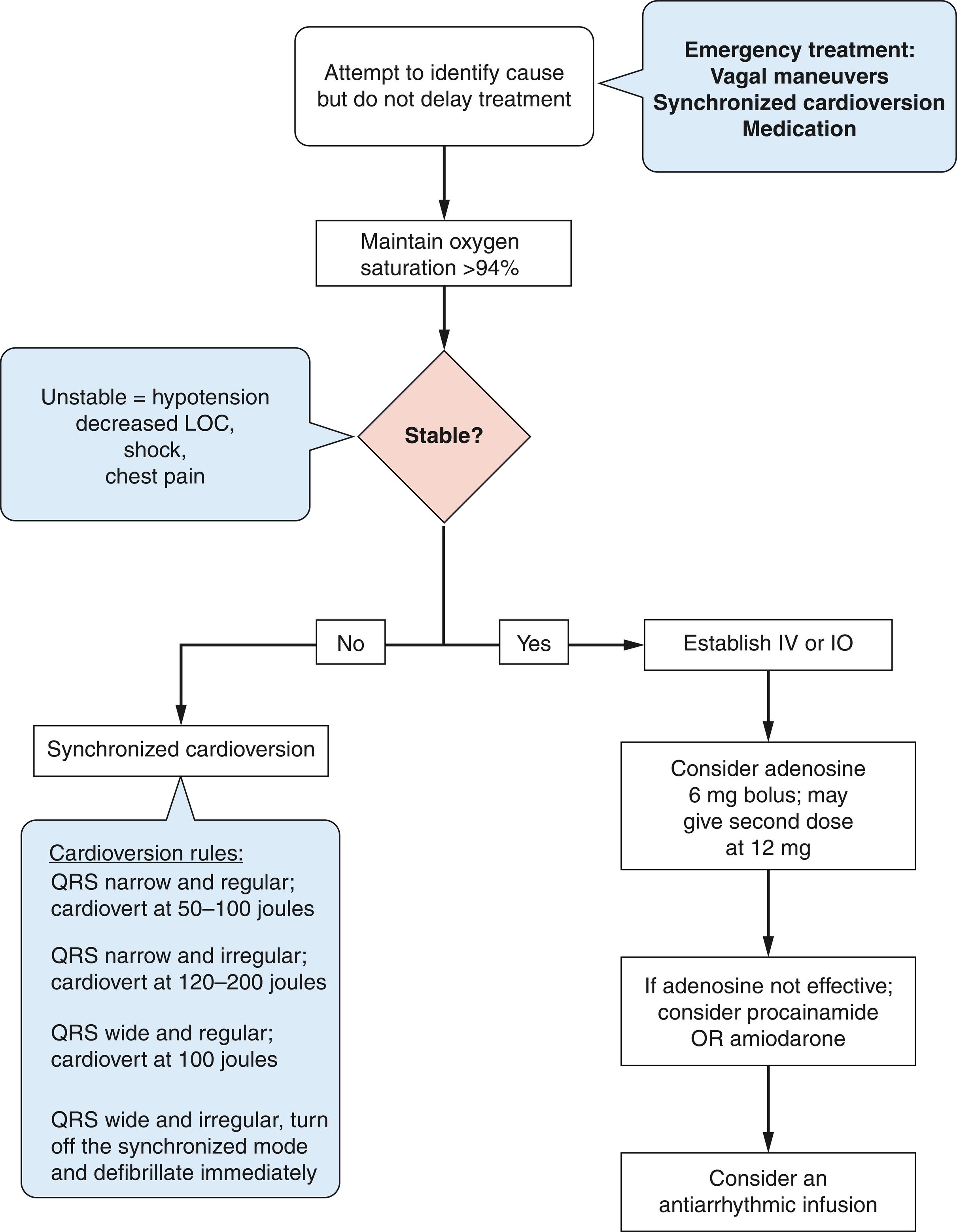
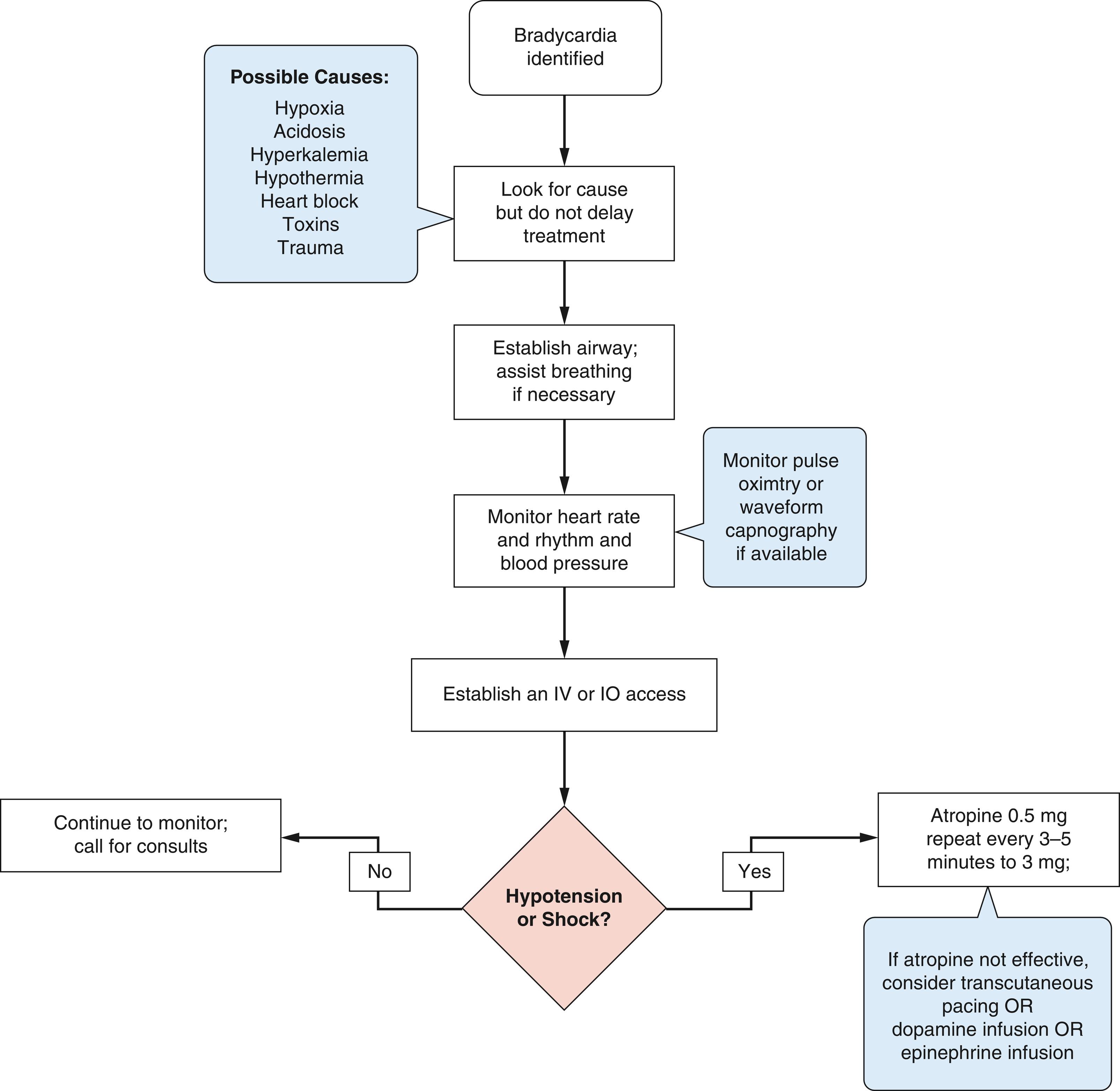
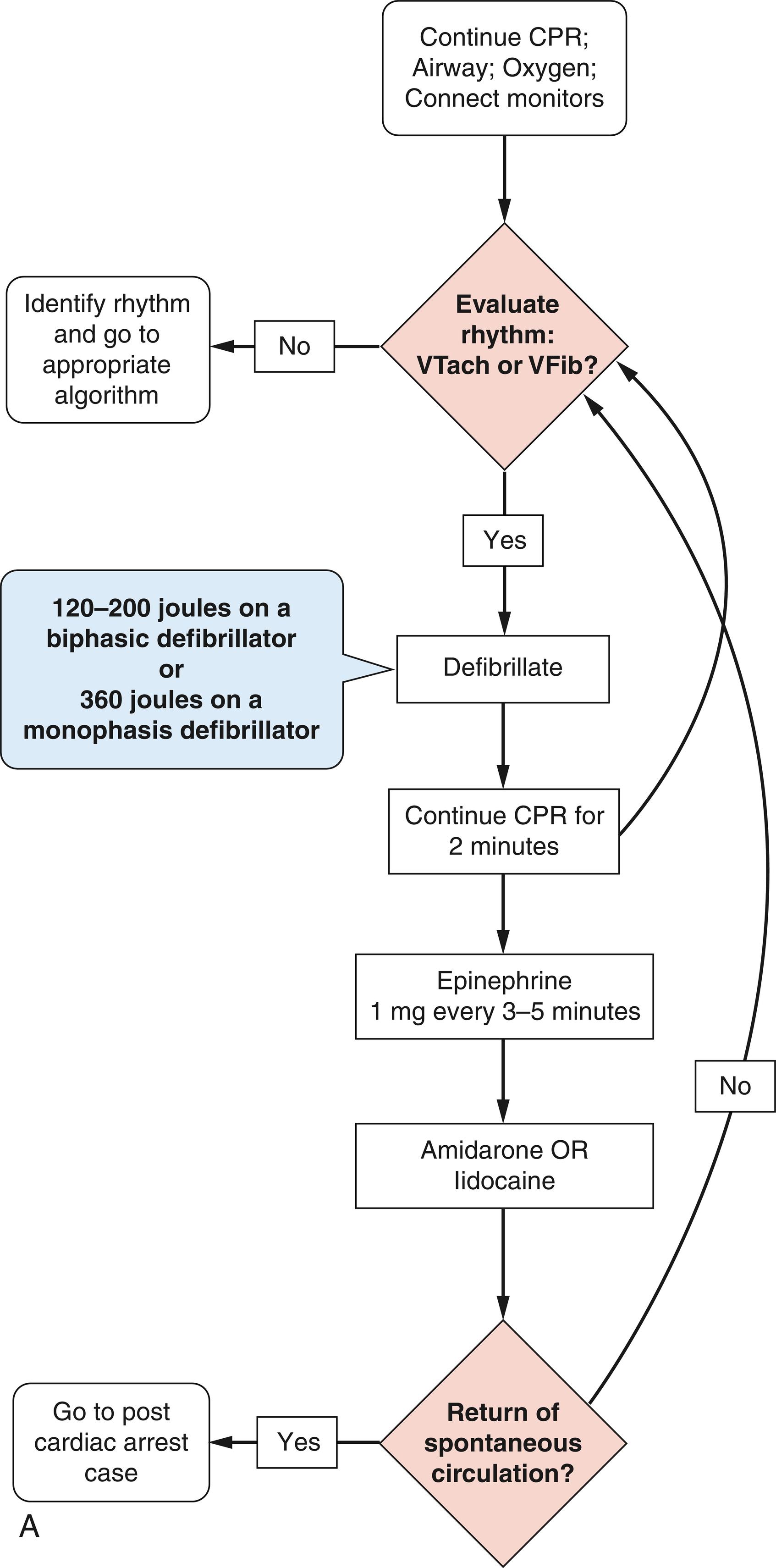
Several factors may influence the generation of arrhythmias under anesthesia. These include anesthetic medications, electrolyte disturbances, hemodynamic or other physiologic causes, and other causes.
Of the amnestic and sedative medications, many anesthetic medications can lengthen the QT interval to greater than 440 milliseconds ( Fig. 15.4 ), including etomidate, ketamine, and volatile agents, though there does not appear to be an increase in the likelihood of malignant arrhythmias with the administration of these medications. In contrast to the other intravenous (IV) amnestics, propofol does not appear to prolong the QT interval. Midazolam does not significantly prolong the QT interval. Dexmedetomidine can decrease sinus node and atrioventricular (AV) nodal function, leading to bradycardia, and can also increase the QT interval. None of the neuromuscular blocking agents—succinylcholine or the nondepolarizing agents—or sugammadex change the QT interval.
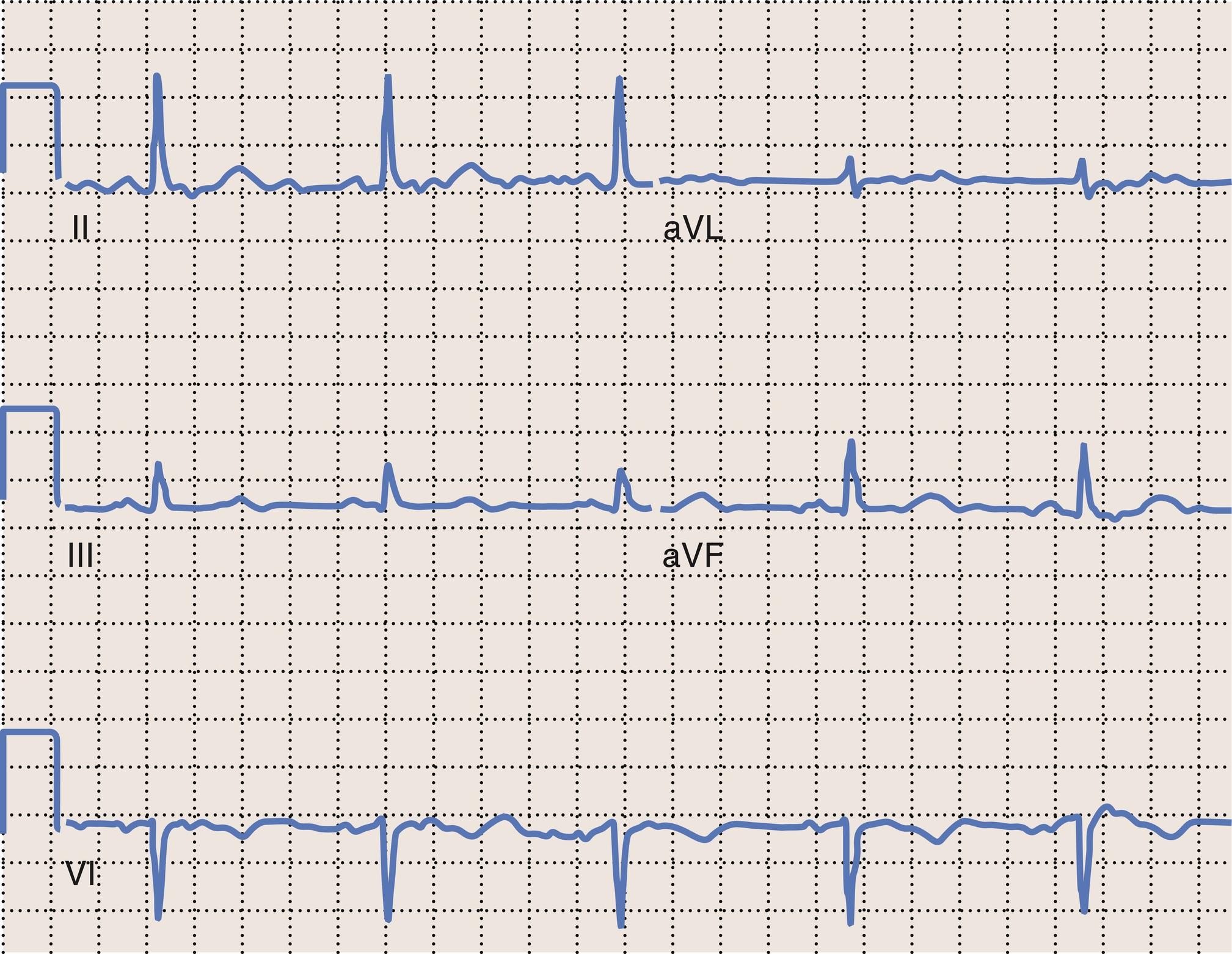
Most opioids do not prolong the QT interval. In fact, some have been shown to shorten the QT interval. Fentanyl at a dose of 2 μg/kg has been shown to decrease QT prolongation associated with laryngoscopy ; however, this effect may be mitigated at higher doses. While remifentanil has not been shown to prolong the QT interval, it has been shown to cause sinus nodal depression and bradycardia. Contrarily, sufentanil has been shown cause QT prolongation in both animal models and human case reports by delaying cardiac cell action potential. Within the opioid group, methadone is the most highly associated with QT prolongation, having been linked with torsades de pointes (TDP) VT ( Fig. 15.5 ), and it appears to be a dose-dependent response. In a large US Food and Drug Administration (FDA) study of over 5000 hospitalized patients, 16 (0.78%) experienced TDP. Even though other drugs used during the perioperative period are not associated with clinically significant QT abnormalities, patients who are receiving chronic methadone therapy prior to and during an anesthetic should have baseline preoperative ECGs as well as close intraoperative and postoperative monitoring, with a high index of suspicion for QT prolongation and TDP.

Droperidol, an antidopaminergic medication that acts as an antiemetic, has experienced decreased use in recent years due to the FDA’s “black box” warning of fatal arrhythmias that have occurred with its administration. However, its recent replacement, ondansetron, which acts on the 5-HT 3 receptor, have been shown to increase QT interval length like its predecessor, droperidol. Thus, caution should be used when both medications are administered together.
Local anesthetics, many of which are used to combat pain in the perioperative period, injected IV or peripherally, such as lidocaine, bupivacaine, and ropivacaine, have not been shown to prolong the QT interval. It is the case, however, that bupivacaine has been shown to increase the QRS width. Any local anesthetics, because of their mechanism of action, will cause a dose-dependent arrhythmia beyond a certain threshold.
Both hypokalemia and hyperkalemia can be associated with a wide variety of tachyarrhythmias, including the “simple” premature ectopic beat to nonsustained VT, sustained VT, or ventricular fibrillation (VF). Hyperkalemia can lead to a variety of conduction abnormalities (e.g., left bundle branch block [LBBB], right bundle branch block [RBBB], bifascicular block, advanced AV block), as well as sinus bradycardia, sinus arrest, VT, VF, and asystole. It is associated with a progression of ECG findings, including peaked T waves, prolongation of PR interval, widening of the QRS complex, loss of P wave, a sine wave, and asystole. Any of these changes can happen instantly, and a progression need not occur.
By widening the QRS complex, hypomagnesemia can lead to a unique form of TDP. It has also been associated with atrial fibrillation and other ventricular arrhythmias. Hypermagnesemia (generally considered any level > 4 mEq/L) may cause bradycardia with associated conduction defects and hypotension. The final outcome for the cardiac muscle with hypermagnesemia is conduction defect leading to no conduction at all, or asystole. Hypocalcemia can prolong the QT interval but has a decreased potential to trigger TDP compared with hypokalemia or hypomagnesemia.
Since electrolytes can be severely altered due to surgical stress, bleeding, and intraoperative medications, when cardiac arrhythmias occur, electrolytes should be checked and corrected as quickly as possible. Patients who take antihypertensives such as diuretics or other rhythm-controlling agents, such as flecainide, should have electrolytes checked and treated preoperatively to reduce the risk of arrhythmia.
Since coronary perfusion pressure is dependent on both aortic root pressure and left ventricular end-diastolic tissue pressure, severe and prolonged intraoperative hypotension can decrease myocardial perfusion, leading to cardiac ischemia and cardiac conduction defects. If a patient experiences diastolic dysfunction or has an elevated left ventricular end-diastolic pressure, sometimes commonly associated with left ventricular hypertrophy (as found in aortic stenosis), the hypotensive effect may be even more pronounced. Similarly, severe hypertension can increase left ventricular wall tension (or afterload), which would increase myocardial oxygen demand, precipitating ischemia and arrhythmias as well. Any patient with blood pressure issues prior to surgery should be screened, in general, by at least an ECG, so as to better guide the anesthetic approach during the perioperative period.
The most common complications of central line placement or pulmonary artery catheter (PAC) placement are transient arrhythmias. Starting from the venae cavae, if the guidewire or catheter enters the right atrium, one may visualize premature atrial contractions (SVT) on the monitor. If the guidewire or catheter passes through the tricuspid valve into the right ventricle, premature ventricular contractions (PVCs) or even VT may develop. In addition, the PAC may cause RBBB. Caution should be used when PACs are inserted in the setting of LBBB, as a complete heart block may ensue. Transcutaneous pacing pads should be placed on the patient for backup pacing capabilities. Caution should also be exercised when inserting PACs in patients who have aortic stenosis, as any arrhythmia can result in loss of diastolic filling time, reduction in cardiac output, severe hypotension, and even death. In rare cases of ventricular septal defect, the PAC may be in the left ventricle, which could also precipitate a tachyarrhythmia.
Intracardiac surgical manipulation, either during cardiac surgical cases (on or off cardiopulmonary bypass), cardiac catheterization lab cases, intrathoracic cases, or lung transplant, may also precipitate arrhythmias. Manipulation of the right atrium, particularly during placement of venous cannulae for cardiopulmonary bypass or coronary sinus cannulae for retrograde cardioplegia, may precipitate atrial fibrillation or SVT. Surgical manipulation of the right ventricle or left ventricle may precipitate VT. Catheter manipulation during electrophysiology cases may also cause atrial or ventricular arrhythmias, though, in many cases, this may be the intended outcome, as those procedures are generally meant to ablate malignant rhythms. During thoracic surgical cases, inadvertent contact with cardiac structures or pulmonary venous structures may precipitate arrhythmias as well. Use of electrocautery directly applied to the myocardium may also precipitate arrhythmias. Low-frequency (50–60 Hz) monopolar cautery leakage is well within the range of precipitating cardiac dysrhythmia (30–110 Hz).
Surgical manipulation of other organs may precipitate reflexes that cause bradycardia. In eye surgery, the activation of stretch receptors in the ciliary ganglion (from extraocular muscle manipulation and traction) are carried by the ophthalmic branch of the trigeminal nerve to the central nervous system, causing a vagal, parasympathetically mediated reflex of either severe bradycardia or asystole. This is called the “oculocardiac reflex” or “Aschner reflex.” Another parasympathetically mediated reflex occurs when the peritoneum is stretched during open or laparoscopic surgery and can cause bradycardia. In both cases, the surgeon should cease manipulation. While the heart rate is expected to increase with cessation of traction, if it does not, one should consider administration of anticholinergics such as glycopyrrolate or atropine.
Finally, electroconvulsive therapy deserves its own consideration. A parasympathetic discharge will follow the initial electrical stimulus, which could cause bradycardia, hypotension, and possibly asystole. After a period of 10–15 seconds, a sympathetic discharge ensues. This discharge increases not only heart rate and blood pressure but also myocardial oxygen consumption. Especially in the vulnerable patient population with coronary artery disease, all of these events may precipitate arrhythmia, including VT. This will start a vicious cycle by which the arrhythmias increase myocardial oxygen consumption and cause ischemia, which may exacerbate the arrhythmias. Care must be taken to treat bradycardia or asystole with anticholinergic agents if needed, and to lower the heart rate and blood pressure if needed to decrease the risk of ischemia, generally with the use of a short-acting beta-receptor blocker.
Tachyarrhythmias are defined by a heart rate greater than 100 beats per minute (bpm) and are divided into two types: narrow QRS complex tachycardias and wide complex QRS tachycardias. Their diagnosis and treatment varies ( Fig. 15.1 ).
Originating above (“supra-”) the AV node, narrow (QRS duration < 120 milliseconds) complex tachycardia activates a rapid ventricular response (RVR) via an intact His-Purkinje conduction system. These SVTs include sinus tachycardia, AV nodal reentrant tachycardia (AVNRT), atrial flutter, atrial fibrillation, and multifocal atrial tachycardia (MAT).
Sinus tachycardia ( Fig. 15.6 ) is a regular heart rhythm that is diagnosed on ECG by a normal P wave followed by a QRS wave and T wave at a rate greater than 100 bpm. In the intraoperative setting, this is usually secondary to sympathetic stimulation because of the procedure in spite of adequate anesthesia, inadequate anesthesia, or blood loss. However, many other causes, minor and serious, insipid and obvious, such as hypoxia, hypercarbia, fever, sepsis, pneumothorax, pulmonary embolism, myocardial ischemia or infarction, thyroid storm, or malignant hyperthermia, should also be considered. Prompt diagnosis with laboratory work and vital sign measurement is necessary, and immediate treatment of the cause of the tachycardia should be initiated. These treatments will vary depending on the cause, and it is inappropriate to treat all cases of sinus tachycardia indiscriminately. For example, one would not administer a beta-receptor blocker to a patient who is volume depleted.
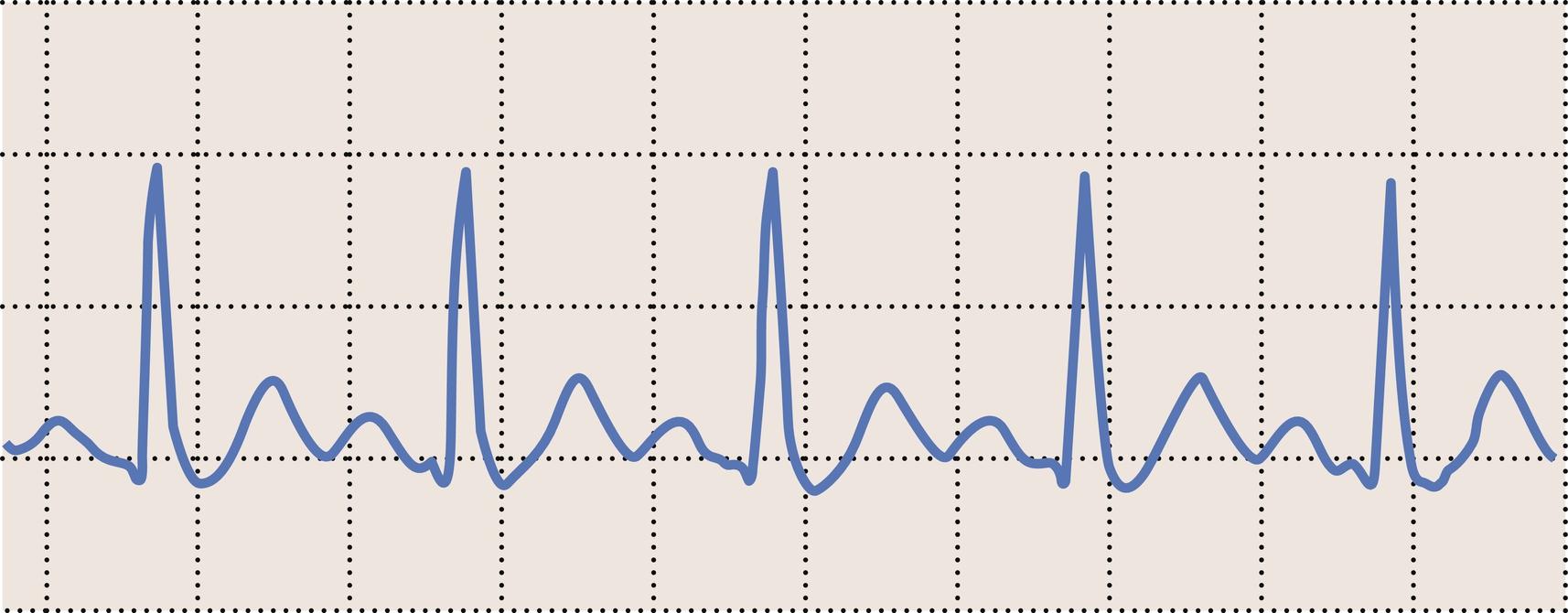
AVNRT ( Fig. 15.7 ) is a regular, paroxysmal SVT that occurs due to formation of a reentry circuit around the AV node. Patients present with heart rates between 150 and 250 bpm. In patients who have AVNRT and hemodynamic compromise (“unstable SVT”) or are under general anesthesia, cardioversion should be attempted. For patients who do not have hemodynamic compromise or altered mental status, adenosine is the first line of treatment to break the rhythm. Vagal maneuvers and calcium channel blockers can also be used.
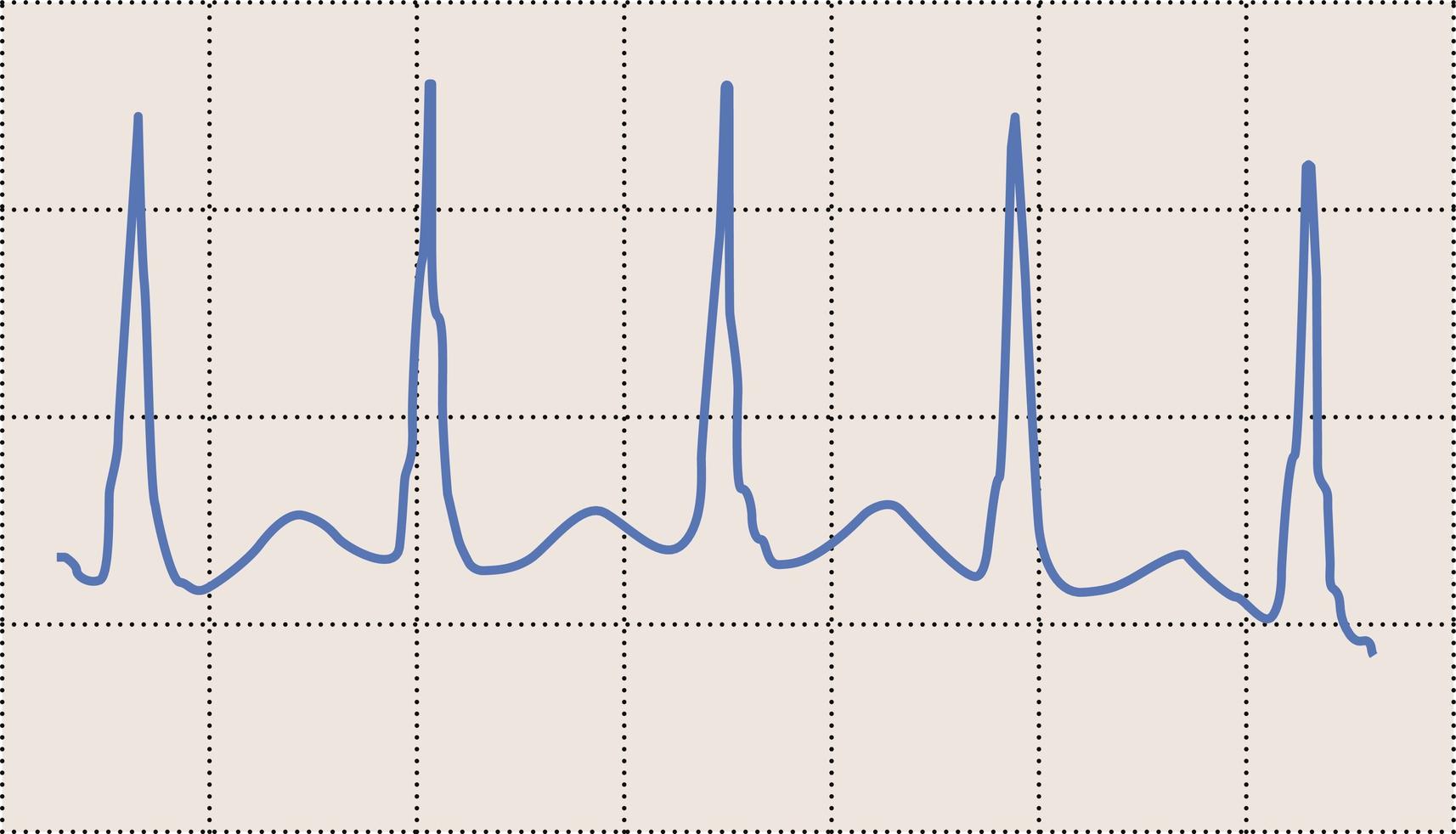
Atrial flutter ( Fig. 15.8 ) is caused by a reentrant circuit in the atria and around the tricuspid valve and generally presents as a regular rhythm with an atrial rate in excess of 300 bpm but a ventricular rate of 130–150 bpm, secondary to the conduction block imposed by the AV node. Atrial fibrillation ( Fig. 15.9 ) is an irregular rhythm characterized by a total absence of P waves on ECG. Foci of the impulses proceed from pulmonary veins or other atrial regions, spreading to the rest of the atria in waves. Ventricular rates < 120 bpm are often hemodynamically well tolerated, whereas RVR rates above 150 bpm are often associated with acute hypotension. Patients who are at high risk for imminent hemodynamic compromise, including patients with aortic or mitral stenosis, or other conditions with increased left ventricular end-diastolic pressure that depend on atrial systolic contribution to left ventricular end-diastolic volume, should be immediately cardioverted with synchrony. Patients who have new-onset atrial fibrillation with RVR should be immediately cardioverted. In patients with known atrial fibrillation and hemodynamically stable RVR, calcium channel blockers or beta-blockers should be attempted to control the rate, as a thrombus can occur in the left atrial appendage (LAA) and an embolic event can occur when sinus rhythm is reestablished. AV nodal blocking agents should be avoided in these patients, as blockade of the AV node may potentiate the preexcitation accessory pathway and degenerate the rhythm into VT or VF.

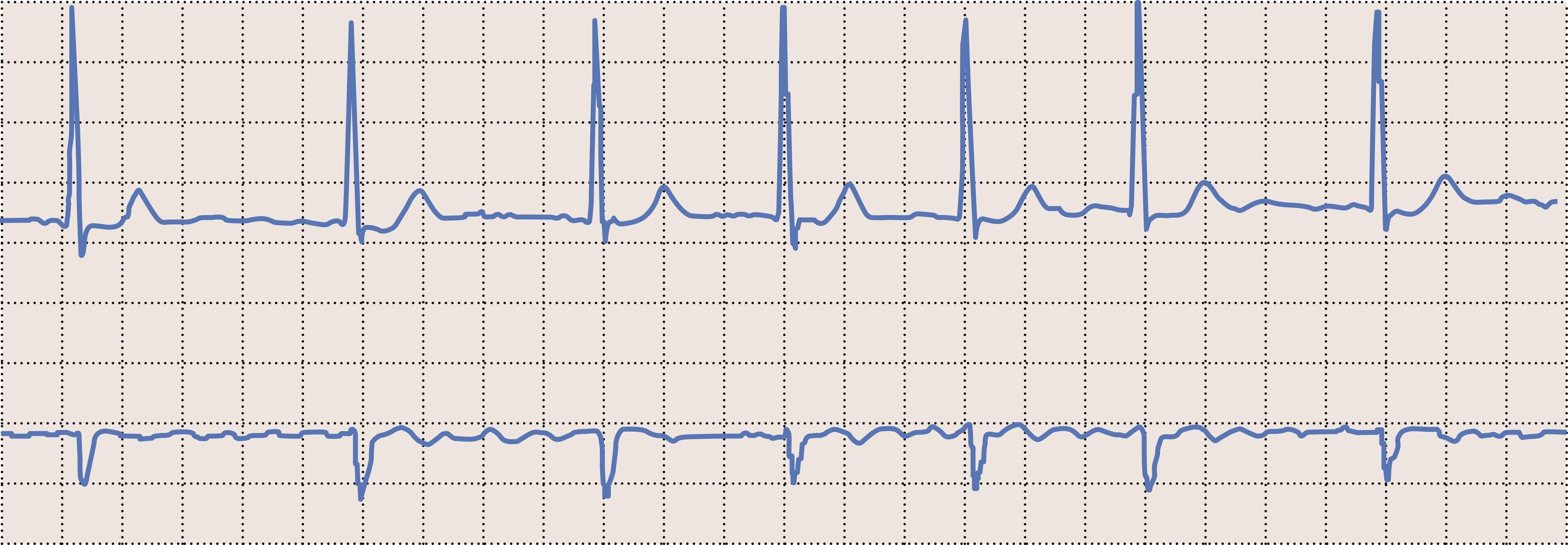
Become a Clinical Tree membership for Full access and enjoy Unlimited articles
If you are a member. Log in here